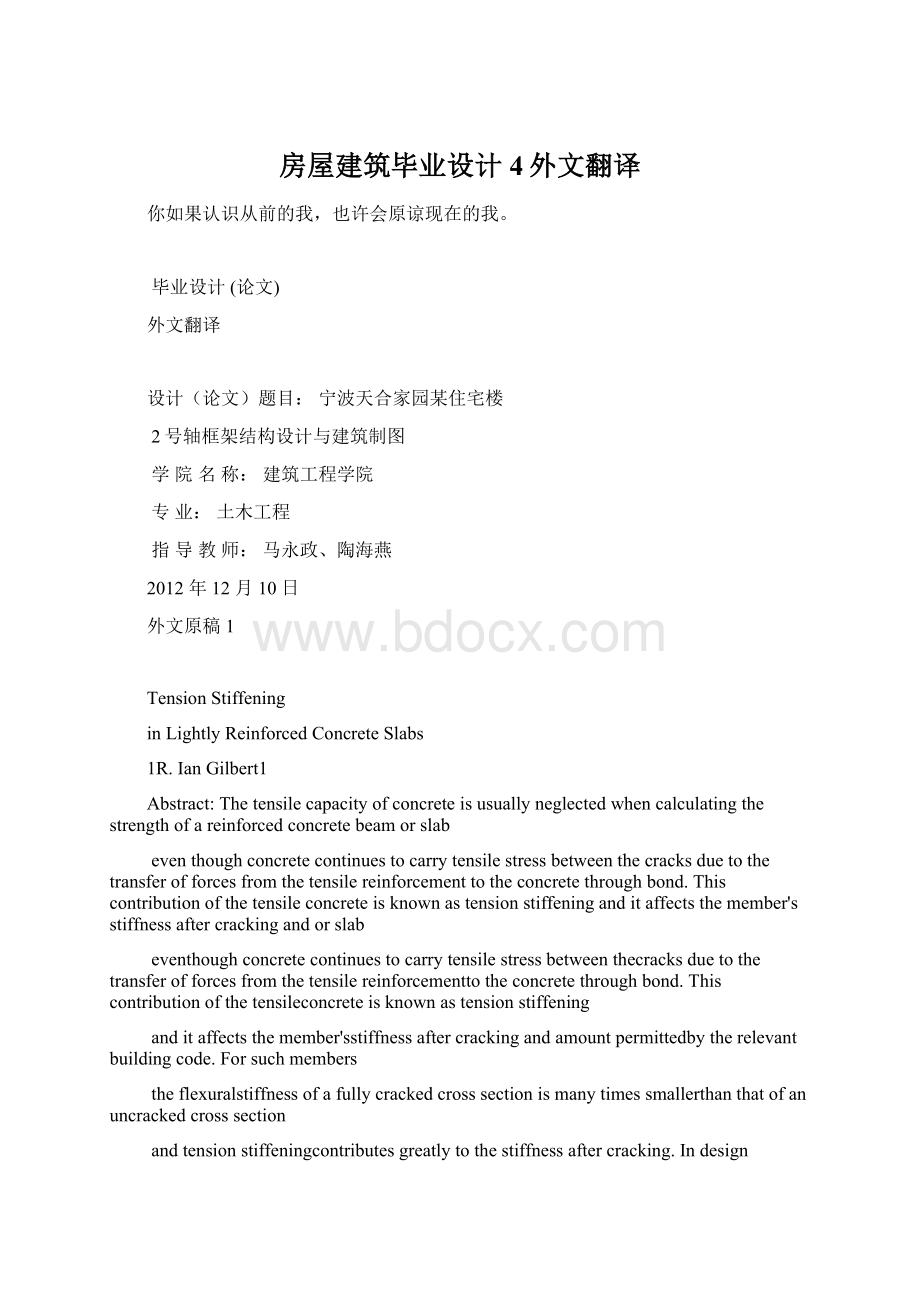房屋建筑毕业设计 4外文翻译Word下载.docx
《房屋建筑毕业设计 4外文翻译Word下载.docx》由会员分享,可在线阅读,更多相关《房屋建筑毕业设计 4外文翻译Word下载.docx(19页珍藏版)》请在冰豆网上搜索。

1R.IanGilbert1
Abstract:
Thetensilecapacityofconcreteisusuallyneglectedwhencalculatingthestrengthofareinforcedconcretebeamorslab
eventhoughconcretecontinuestocarrytensilestressbetweenthecracksduetothetransferofforcesfromthetensilereinforcementtotheconcretethroughbond.Thiscontributionofthetensileconcreteisknownastensionstiffeninganditaffectsthemember'
sstiffnessaftercrackingandorslab
eventhoughconcretecontinuestocarrytensilestressbetweenthecracksduetothetransferofforcesfromthetensilereinforcementtotheconcretethroughbond.Thiscontributionofthetensileconcreteisknownastensionstiffening
anditaffectsthemember'
sstiffnessaftercrackingandamountpermittedbytherelevantbuildingcode.Forsuchmembers
theflexuralstiffnessofafullycrackedcrosssectionismanytimessmallerthanthatofanuncrackedcrosssection
andtensionstiffeningcontributesgreatlytothestiffnessaftercracking.Indesign
deflectionandcrackcontrolatservice-loadlevelsareusuallythegoverningconsiderations
andaccuratemodelingofthestiffnessaftercrackingisrequired.
Themostcommonlyusedapproachindeflectioncalculationsinvolvesdetermininganaverageeffectivemomentofinertia[Ie]foracrackedmember.SeveraldifferentempiricalequationsareavailableforIe
includingthewell-knownequationdevelopedbyBranson[1965]andrecommendedinACI318[ACI2005].OthermodelsfortensionstiffeningareincludedinEurocode2[CEN1992]andthe[BritishStandardBS81101985].Recently
Bischoff[2005]demonstratedthatBranson'
sequationgrosslyoverestimatesthtieaveragesffnessofreinforcedconcretememberscontainingsmallquantitiesofsteelreinforcement
andmomentreachestheflexuraltensilestrengthoftheconcreteormodulusofrupture
fr.Thereisasuddenchangeinthelocalstiffnessatandimmediatelyadjacenttothisfirstcrack.Onthesectioncontainingthecrack
theflexuralstiffnessdropssignificantly
butmuchofthebeamremainsuncracked.Asloadincreases
morecracksformandtheaverageflexuralstiffnessoftheentirememberdecreases.
Ifthetensileconcreteinthecrackedregionsofthebeamcarriednostress
theload-deflectionrelationshipwouldfollowthedashedlineACDinFig.1.Iftheaverageextremefibertensilestressintheconcreteremainedatfraftercracking
theloaddeflectionrelationshipwouldfollowthedashedtheactualresponseliesbetweenthesetwoextremesandisshowninFig.1asthesolidlineAB.Thedifferencebetweentheactualresponseandthezerotensionresponseisthetensionstiffeningeffect(inFig.1).
Astheloadincreases
theaveragetensilestressintheconcretereducesasmorecracksdevelopandtheactualresponsetendstowardthezerotensionresponse
atleastuntilthecrackpatternisfullydevelopedandthenumberofcracksdeflectioncalculations.
3.ModelsforTensionStiffening
TheinstantaneousdeflectionofbeamorslabatserviceloadsmaybecalculatedfromelastictheoryusingtheelasticmodulusofconcreteEcandaneffectivemomentofinertia
Ie.ThevalueofIeforthememberisthevaluecalculatedusingEq.[1]atmidspanforasimplysupportedmemberandaweightedaveragevaluecalculatedinthepositiveandnegativemomentregionsofacontinuousspan
(1)
whereIcr=momentofinertiaofthecrackedtransformedsection;
Ig=momentofinertiaofthegrosscrosssectionaboutthecentroidalaxis[butmorecorrectlyshouldbethemomentofinertiaoftheuncrackedtransformedsection
Iuncr];
Ma=maximummomentinthememberatthestagedeflectioniscomputed;
Mcr=crackingmoment=(frIgyt);
fr=modulusofruptureofconcrete(=7.5fcinpsiand0.6fcinMpa);
andyt=distancefromthecentroidalaxisofthegrosssectiontotheextremefiberintension.
AmodificationoftheACIapproachisincludedintheAustralianStandardconcretemayreducethecrackingmomentsignificantly.ThecrackingmomentisgivenbyMcr=(fr?
fcs)Igyt
wherefcsismaximumshrinkage-inducedtensilestressintheuncrackedsectionattheextremefibreatwhichcrackingoccurs(Gilbert2003).
(2)
where_distributioncoefficientaccountingformomentlevelanddegreeofcrackingandisgivenby
(3)
and1=1.0fordeformedbarsand0.5forplainbars;
2=1.0forasingle
short-termloadand0.5forrepeatedorsustainedloading;
sr=stressinthetensilereinforcementattheloadingcausingfirstcracking(i.e.
whenthemomentequalsMcr)
calculatedwhileignoringconcreteintension;
sisreinforcementstressatloadingunderconsideration(i.e.
whenthein-servicemomentMsisacting)
cr=curvatureatthesectionwhileignoringconcreteintension;
anduncr=curvatureontheuncrackedtransformedsection.
Forslabsinpureflexure
ifthecompressiveconcreteandthereinforcementarebothlinearandelastic
theratiosrsinEq.(3)isequaltotheratioMcrMs.UsingthenotationofEq.
(1)
Eq.
(2)canbereexpressedas
(4)
Foraflexuralmembercontainingdeformedbarsundershorttermloading
Eq.(3)becomes_=1?
(McrMs)2andEq.(4)canberearrangedtogivethefollowingalternativeexpressionforIeforshort-termdeflectioncalculations[recentlyproposedbyBischoff(2005)]:
(5)
Thisapproach
which.
4parisonwithExperimentalData
TotesttheapplicabilityoftheACI318
Eurocode2
andBS8110approachesforlightlyreinforcedconcretemembers
themeasuredmomentversusdeflectionresponsefor11simplysupported
singlyreinforcedone-wayslabscontainingtensilesteelquantitiesintherange0.0018<
<
0.01arecomparedwiththecalculatedresponses.Theslabs(designatedS1toS3
S8
SS2toSS4
andZ1toZ4)wereallprismatic
ofrectangularsection
850mmwide
andcontainedasinglelayeroflongitudinaltensilesteelreinforcementataneffectivedepthd(withEs=200
000MPaandthenominalyieldstressfsy=500Mpa).DetailsofeachslabaregiveninTable1
includingrelevantgeometricandmaterialproperties.
Thepredictedandmeasureddeflectionsatmidspanforeachslabwhenthemomentatmidspanequals1.1
1.2
and1.3McrarepresentedinTable2.Themeasuredmomentversusinstantaneousdeflectionresponseatmidspanoftwooftheslabs(SS2andZ3)arecomparedwiththecalculatedresponsesobtainedusingthethreecodeapproachesinFig.2.Alsoshownaretheresponsesifcrackingdidnotoccurandiftensionstiffeningwasignored.
5.DiscussionofResults
Itisevidentthatfortheselightlyreinforcedslabs
tensionstiffeningisverysignificant
providingalargeproportionofthepostcrackingstiffness.FromTable2
theratioofthemidspandeflectionobtainedbyignoringtensionstiffeningtothemeasuredmidspandeflection(overthemomentrangeMcrto1.3Mcr_)isintherange1.38-3.69withameanvalueof2.12.Thatis
onaverage
tensionstiffeningcontributesmorethan50%oftheinstantaneousstiffnessofalightlyreinforcedslabaftercrackingatserviceload.
Foreveryslab
theACI318approachunderestimatestheinstantaneousdeflectionaftercracking
particularlysoforlightlyreinforcedslabs.Inaddition
ACI318doesnotmodeltheabruptchangeindirectionofthemoment-deflectionresponseatfirstcracking
nordoesitpredictthecorrectshapeofthepostcrackingmoment-deflectioncurve.
Theunderestimationofshort-termdeflectionusingtheACI318modelisconsiderablygreaterinpracticethanthatindicatedbythelaboratorytestsreportednatureofcracking
theagreementbetweentheEurocode2predictionsandthetestresultsoversuchawiderangeoftensilereinforcementratiosisquiteremarkable.Withtheratioof()inTable2varyingbetween0.80and1.39withameanvalueof1.07
theEurocode2approachcertainlyprovidesabetterestimateofshort-termbehaviorthaneitherACI318orBS8110.
6.Conclusions
Althoughtensionstiffening11laboratorytestsonslabscontainingvaryingquantitiesofsteelreinforcement.TheEurocode2approach(Eq.(5)
并在一个有效深度载有纵向拉伸单层钢筋d(Es=200000MPa和屈服应力=500MPa)
每个板块的详细情况见表1
包括有关的几何和材料特性
在每个板跨中挠度的预测结果与实测时
在跨中力矩等于1.1
1.2和1.3Mcr列出在表2
与瞬时变形响应的测量力矩的两跨中的板
(SS2andZ3)进行比较和计算结果获得图2
使用三个代码方式同时显示的结果
如果没有出现开裂
如果张力加劲被忽略
5.讨论结果
很明显
这些轻型钢筋板
张力加劲非常显著
提供一个大比例的开裂后刚度
从表2
跨中挠度的比例得到了加劲
对测量张力跨中挠度忽视(在Mcr和1.3Mcr范围)是在1.38-3.69范围
取平均值2.12
也就是说
平均而言
张力加劲超过50%的一个轻型钢筋板在屈服荷载的瞬间开裂
对于每一个板
在ACI318的方法低估了瞬间挠度后开裂
特别是对于轻型钢筋板
此外
在这一时刻ACI318突然不成模型
在起初开裂处
突然改变力矩偏转结果的方向
也没有预测的正确形状矩挠度曲线
在短期挠度的低估使用ACI318模式是经化验报告在这里在表示实践中相当大的比
不同于Eurocode2和BS8110
ACI318模型不承认或为在开裂的力矩
这将不可避免地减少在实践中出现的由于张力引起的混凝土干燥收缩或热变形
对于许多板
因早期干燥或温度变化在数周内将发生铸件的开裂
以及经常暴露之前
其板全方位服务的负荷
通过限制混凝土拉伸应力水平的拉伸筋只有1.0MPa
BS8110的方法对测试板的上下挠度和立即高于开裂力矩的高估
由于约束的早期收缩和热变形
这并非不合理和占损失的刚度发生在实践中
不过
BS8110提供了一个相对较差模型刚度
并错误地认为
平均拉力混凝土裂缝进行了实际调高M增大和中性轴的上升
因此
BS8110开裂后力矩偏转斜率图甚至超过了所有板测量斜坡
这种方法使用比Eurocode2或ACI两种方式更繁琐
在所有情况下
Eurocode2挠度计算[EPS.(3)-(5)]是在更接近与实测挠度在整个负载范围内协议
可以看出在图2
荷载-挠度曲线的形状并使用Eurocode2是一个比这更好的代表性实际曲线结果
使用EP.
(1)
考虑到具体的变异材料性能影响的板
该协议Eurocode2在运行特征和对开裂的随机性之间的预测和试验结果在如此广泛的受拉钢筋比率是相当显著的
在图2()0.80和1.39之间的值平均值为1.07
Eurocode2的方法提供了ACI318或BS8110更好地估计短期行为
6.结论
虽然张力加劲只对重钢筋梁挠度的影响相对较小
这是非常重要的对于IuncrICR的比例很高的轻型钢筋构件
例如作为最实用的钢筋混凝土楼板
加劲张力的模型纳入ACI(2005)
Eurocode2(CEN1993)
和BS8110(1985)已提交并且轻型钢筋混凝土楼板的适用性已进行评估
计算模型的三个代码瞬时挠度进行了比较与来自11个实验室测试测量挠度在含有不同数量的钢筋板
在Eurocode2方案EP.(5)已被证明是更准确地模拟了瞬时负载变形的加固构件轻型钢筋构件的波形和ACI318(EP.
(1)比更为可靠的方法
出自:
JOURNALOFSTRUCTURALENGINEERING(c)ASCEJUNE2007